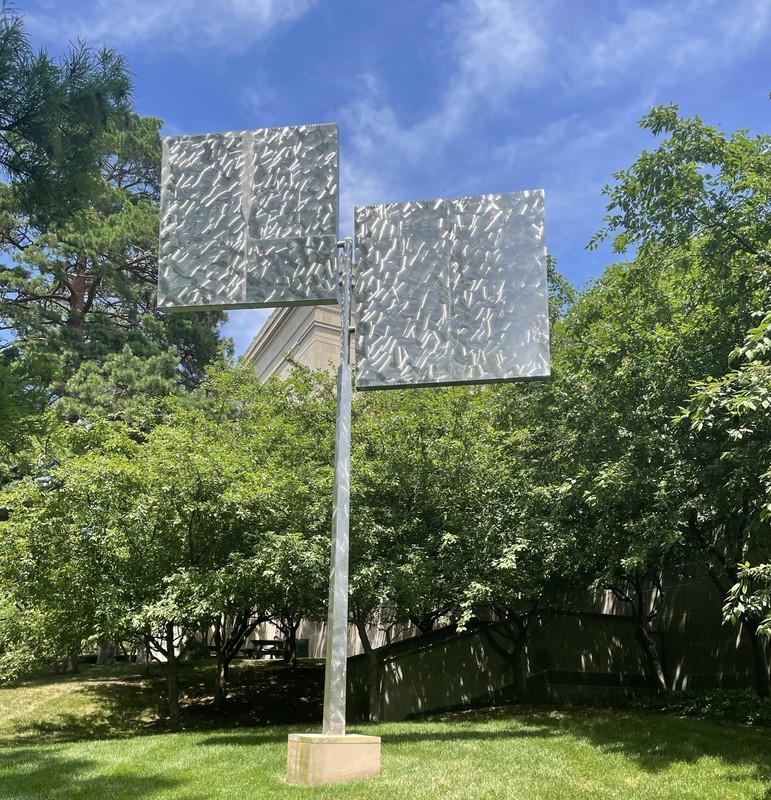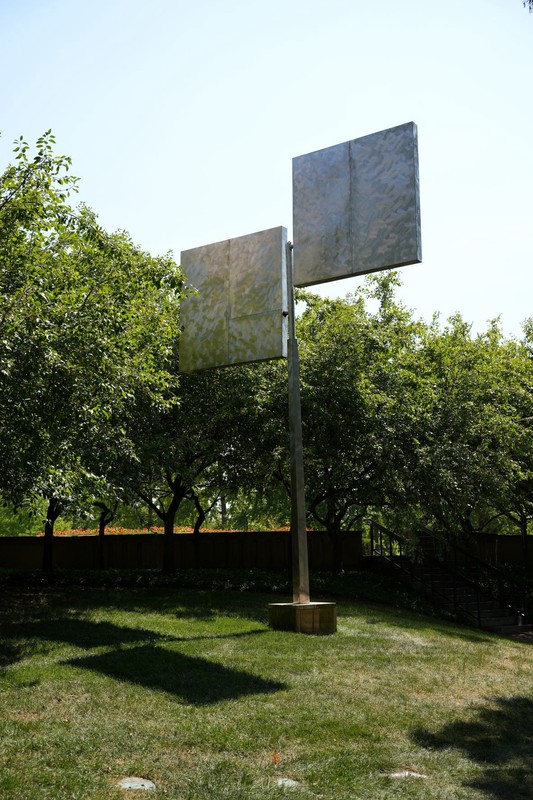Two Planes Vertical-Horizontal
Introduction
Author-Uploaded Audio
Listen to an introduction to the sculpture by KCUR's Steve Kraske
Text-to-speech Audio
Dedicated in 1968, this kinetic sculpture by George Rickey was designed with an intricate system of bearings and counterweights so that it could move with the wind. This theme of balance and movement is present throughout many of Rickey's works, and this sculpture which was a gift to the museum from the Sosland family reflects the artist's background as both an engineer and an artist. Kansas City was home to the first of four similar sculptures by Rickey that can now be seen in New York, Seattle, and on the Princeton campus in New Jersey. A gift to Kansas City from the Sosland Family, Similar to other works by Rickey, the kinetic sculpture balances not just two planes, but the mathematical precision of an engineer and the unpredictability of the wind. For some, the work is a representation of the need for balance between forces we can predict that keep the two planes balanced, and those we cannot such as the wind that causes the planes to move.
Images
Two Planes Vertical-Horizontal

Two Planes Vertical-Horizontal

Backstory and Context
Text-to-speech Audio
George Rickey was born on June 6, 1907 in South Bend, Indiana. While his father was an engineer, Rickey decided to study art and taught history in the early years of the Great Depression before becoming an art teacher and artist. Rickey became a professor of art in 1941 at Muhlenberg College in Allentown, Pennsylvania but left the following year to serve in the army where he worked as an engineer. He returned to Muhlenberg College after the war and later accepted positions at Indiana University and Tulane University among other academic positions and appointments as an artist in residence.
Rickey's first major honor for his work came in 1960 when he was awarded a fellowship from the John Simon Guggenheim Memorial Foundation. In the late 1960s and early 1970s, Rickey creates a series of kinetic sculptures with planes that were balanced but also designed to move in relation to wind. For some who walk through the sculpture park at the Nelson-Atkins Museum, this metallic piece both stands out and blends in with the trees and also moves with the wind.
For some, this kinetic work resembles a tree with it's metallic trunk and the burnished surfaces on the two squares that may resemble leaves. Shortly before his passing at the age of 95 in 2002, Rickey was awarded the Lifetime Achievement in Contemporary Sculpture Award from the International Sculpture Center, Washington, D.C. After his passing, the artist was honored with a memorial at the Guggenheim Museum.
“I am not an inventor. I have learned that 'new' does not mean 'good,' that novelty is seductive but treacherous. This does not mean that I don’t have a frontier to explore. I am deeply interested in what lies just beyond the frontier. I try to cross it, to glimpse what awaits there, as discovery, as a possibly expressive language. What lies there is not new; it has been there all the time, waiting to be used.” George Rickey, 1985.
Sources
Gallery Labey, Two Planes Vertical-Horizontal, Nelson-Atkins Museum. Accessed July 7th 2022.
Two Planes Vertical Horizontal II, 1970, Campus Art Princeton . Accessed August 19th, 2022. https://artmuseum.princeton.edu/campus-art/objects/31505?lat=40.3484&lon=-74.6578.
Rosa Sittig-Bell. Object of the Week: Two Plane Vertical Horizontal Variation III, Seattle Art Museum Blog. August 5th, 2022. Accessed August 19th, 2022. https://samblog.seattleartmuseum.org/2022/08/rickey-two-plane/.
Photo by David Trowbridge
Photo by David Trowbridge
